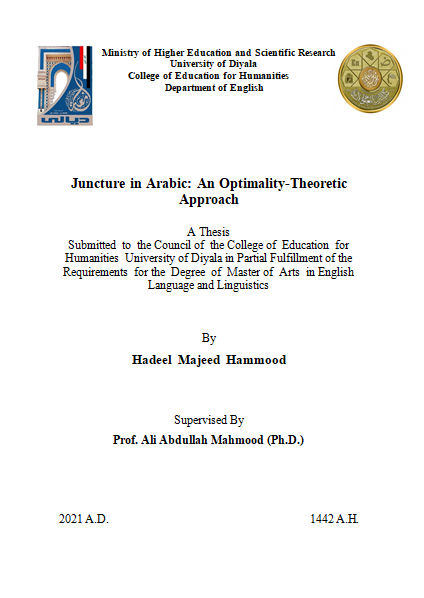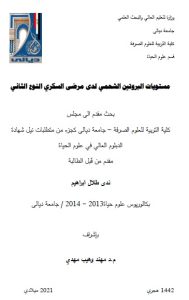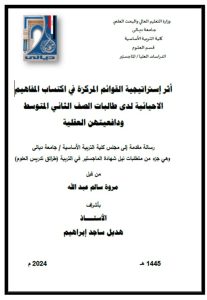ABSTRACT
The present thesis takes the Optimality Theory (OT) as a model for the analysis of juncture in Arabic. The study focuses on Waqf (juncture) 1 in the Glorious Quran (GQ). To the best of our knowledge, this topic has never been dealt with from the optimality-theoretic approach. It is the first study of its type in the Arab homeland and in the world. It is special because of two reasons: first, the analysis of juncture is done in the Quranic texts with all its difficulties on the syntactic, morphological, semantic and phonological aspects. Second, such analysis has been executed within the light of modern linguistics, in general and OT, in particular. Most of the previous studies, if not all, have dealt with Waqf (juncture) in the GQ from either religious or traditional linguistic point of view. The latter has been achieved in terms of parsing and syntactic relations. This work is completely different from those studies in that it tackles Waqf (juncture) as a pure phonological process in relation to other components of language, particularly semantics.
The OT was first launched as a theory of phonology by Prince and Smolensky in 1993 and expanded by McCarthy in 1995. The theory introduces itself through Tableaux which offer good explanation to juncture in Arabic. They facilitate the problem of the optimal output through the interaction between several candidates and several constraints. According to this theory, juncture is analyzed in terms of markedness, faithfulness and alignment constraints. It also works within Hendriks and De Hoop’s double-index semantic framework (2001) which claims that context does not have the only role of determining the realized explicit and implicit meaning expressed by the Ayas, but also the semantic function of fixing the most harmonic surface forms of these Ayas with all appropriate types of juncture in Arabic.
The thesis examines 30 Ayas, considered as a yardstick for the exploration of juncture in the language of the Glorious Quran (GQ). The overall results show that the hierarchy of the constraints is different from one Aya to another due to the type and function of juncture. Moreover, the phonological, semantic and syntactic constraints differ in their selection of the optimal occurrence of juncture depending on the priority of these components. This finding confirms that the phonological constraints show their prevalence over the other constraints which affect the realized meaning of each Aya. For the constraints themselves, the results indicate that the RM-JUNC constraint exceeds all other constraints, and it achieves the interaction of phonological and semantic factors of juncture in the GQ . Moreover, the results show that the principles and constraints of OT are applied to the analysis of Waqf in the GQ, and thus proved the main hypothesis of the thesis.
This thesis comprises six chapters.Chapter one presents statement of the problem, the hypothesis, the procedures, aims, limitation and significance of the study . Chapter two sketches out the theoretical background of juncture. It gives an explanation of 'juncture' as a phonological process and discusses its types along with a specific section for the traditional view of Arabic juncture.
In chapter three, there is a description of the phonemic inventory of Arabic which uncovers the phonological nature of Arabic segments, their functions and prosodic features. At the same time, the thesis questions a number of proposals related to juncture in Arabic, including prosodic structure, syllable typology, stress, foot, mora and minimality concept which supply empirical adequacy and formal correctness to the thesis proposal.
Chapter four explains the methodological framework employed in this study including the OT as the adopted phonological model, the directionality of its constraints application and the data. Also, there is a brief description of the fundamental principles of this theory and its advantages and disadvantages.
The central and foundational part of the thesis is chapter five. It presents an optimality-theoretic analysis of juncture in Arabic with all its linguistic, para- and extra-linguistic features which contribute a lot in the occurrence and types of this phonological process. A distinction is also made between religious-based juncture and its linguistic counterpart. This depends heavily on their analytical orientation and stance. This qualitative analysis has been carried out on how juncture displays its characteristics in relation to phonological, semantic and syntactic aspects of the Quranic texts. Moreover, the chapter includes the findings that the study has reached at and their discussion in order to answer the thesis questions and prove its hypotheses through empirical examples. The study ends up with a number of conclusions, recommendations and suggestions for further studies in chapter six.





